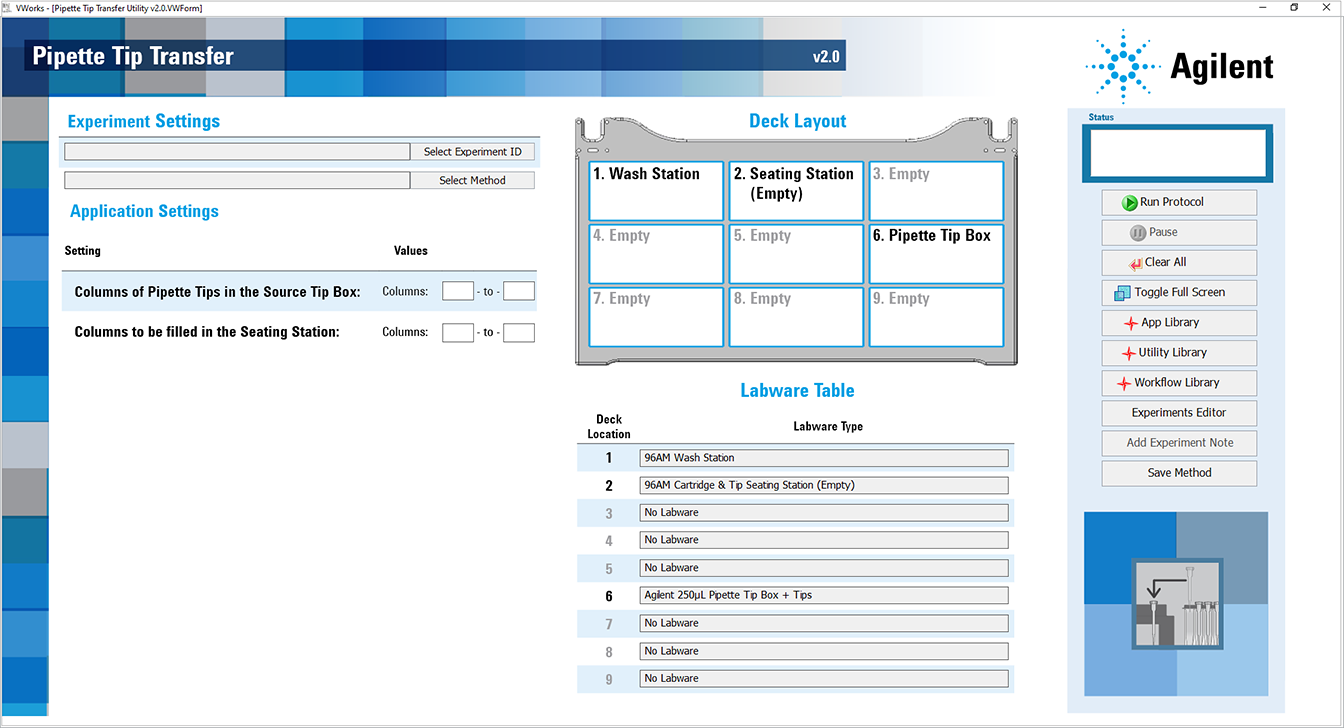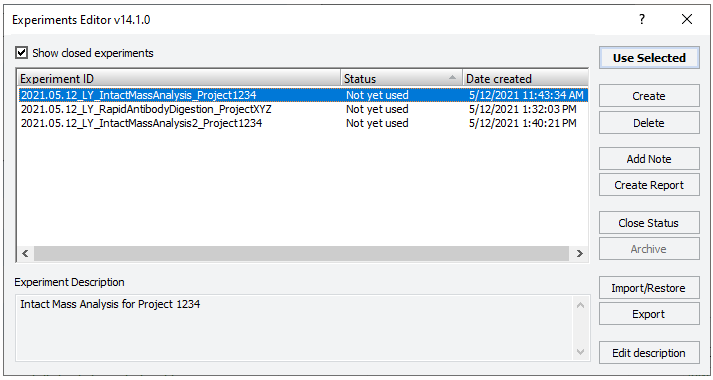Pipette Tip Transfer v2.0 User Guide

The Pipette Tip Transfer utility moves 1–12 columns of Agilent 250-µL pipette tips from a source tip box at AssayMAP Bravo deck location 6 into an empty 96AM Cartridge & Tip Seating Station at deck location 2. This utility is designed to transfer contiguous, full columns of tips, where each column has eight pipette tips.
Before you start
The following figure shows the required deck layout.
 |
On the AssayMAP Bravo deck, make sure:
• The empty seating station is at deck location 2.
• An Agilent 250-µL tip box is properly positioned at deck location 6. The tip box may be full or partially filled with pipette tips.
For partially filled tip boxes, ensure that the tips are arranged in contiguous, full columns of eight pipette tips each.
Make sure that the tip box lid has been removed.
• The 96AM Wash Station or the later model 96 Channel Wash Station is at deck location 1.
• All other deck locations are empty.
Experiment ID and method requirements
Each workbench application and utility has an Experiment Settings section that allows you to select an experiment ID and a method.
• An experiment ID is a database record that captures the steps executed and the settings used during each run of an application or utility. Any errors that may have occurred during a run are also recorded.
To create an experiment ID, you open the Experiments Editor by clicking  in any Workbench app or utility. For details, go to the Literature Library and open Using the Protein Sample Prep Workbench. In the browser that opens, click Using Experiment IDs.
in any Workbench app or utility. For details, go to the Literature Library and open Using the Protein Sample Prep Workbench. In the browser that opens, click Using Experiment IDs.
 in any Workbench app or utility. For details, go to the Literature Library and open Using the Protein Sample Prep Workbench. In the browser that opens, click Using Experiment IDs.
in any Workbench app or utility. For details, go to the Literature Library and open Using the Protein Sample Prep Workbench. In the browser that opens, click Using Experiment IDs.• A method is a comprehensive collection of saved settings for an application or utility, which you can use to run the application or utility.
Experiment IDs and methods are required for compliance-enabled VWorks editions and optional for noncompliance-enabled VWorks editions.
VWorks edition | Experiment ID and method selection |
|---|---|
VWorks Plus | Required |
VWorks Standard | Optional |
Setting up the protocol
Before starting the protocol, make sure the appropriate selections and values are specified in the Pipette Tip Transfer utility.
To set up the protocol:
1 Open the Utility Library.
2 Locate Pipette Tip Transfer, and then click Utility.
 |
The Pipette Tip Transfer utility opens.
 |
3 If applicable, click Select Experiment ID.
 |
The Experiments Editor opens.
 |
4 Select the Experiment ID that you want to use to record the steps performed during this application run, and then click Use Selected.
The Experiments Editor closes.
5 In the form, click Select Method to locate and select a method.
In the Open File dialog box, select the method, and click Open.
• To run the selected method, go to Starting the Pipette Tip Transfer run.
• To create or modify a method, proceed to step 6.
VWorks Plus. Administrator or technician privileges are required to create and modify methods.
6 In the Application Settings area, specify the following settings for the run:
Setting | Description |
|---|---|
Columns of pipette tips in the Source Tip Box | Specifies the range of pipette tips initially present in the pipette tip box before the run starts.  • Left field is the first column that contains tips. • Right field: is the last column that contains tips. For example: • For a full tip box: left field = 1, right field = 12 • For partially filled tip box with tips in columns 6 - 10: left field = 6, right field = 10 |
Columns to be filled in the Seating Station | Specifies the range of wells to be filled with tips in the seating station at deck location 2.  • In the left field, specify the column number of the first column in the seating station that will contain tips after completing the transfer. • In the right field, specify the column number of the last column in the seating station that will contain tips after completing the transfer. |
7 To save the method:
a Click  .
.
 .
.b In the Save File As dialog box, type the file name and click Save.
VWorks Plus. You must save the method before you can run it.
Starting the Pipette Tip Transfer run
To start the protocol run:
1 Ensure that the accessories and pipette tip box are at the assigned deck locations, as shown in the Deck Layout image of the form.
Make sure the labware are properly seated on the Bravo deck.
 |
2 Click  to start the run.
to start the run.
 to start the run.
to start the run. To monitor the progress of the run, check the Status box. For a summary of the movements, see Automation movements during the Pipette Tip Transfer protocol.
 |
When the run is finished, remove the Pipette Tip Box from deck location 6 from the deck.
To pause the run, click Pause. The task currently in progress finishes before the protocol pauses. The Scheduler Paused dialog box opens. For details, see Emergency stops and pauses.
To troubleshoot errors, see the Error Recovery Guide and the Bravo Platform User Guide in the Literature Library page of the Protein Sample Prep Workbench.
Automation movements during the Pipette Tip Transfer protocol
This section describes the basic movements of the AssayMAP Bravo Platform during the Pipette Tip Transfer protocol using the Default Method settings. Changing the selections or parameters will alter the movements.
Protocol step | Head moves to deck location... | Action |
|---|---|---|
1 | 1 | Dispenses any liquid remaining in the syringes into the wash station. |
2 | 6 | Presses on the pipette tips while the head is centered above the tip box, even if the tip box is only partially full. Note: A collision will result if the head is offset from the tip box location when pressing on pipette tips. |
3 | 2 | Ejects the pipette tips into the seating station. |
4 | 2 | If applicable, picks up any columns of excess pipette tips from the seating station. The number of excess tips is calculated from the Application Settings. If Application Settings specify that the number of columns of pipette tips in the tip box matches the number of columns of pipette tips to be transfered into the seating station, this step is skipped. Note: The head is offset to the right of the seating station, instead of centered above the station, when picking up excess columns of pipette tips. |
5 | 6 | If applicable, ejects any excess pipette tips back into the tip box. Note: Excess tips are always returned to the left side of the tip box, starting at column 1. |
6 | 2 | If applicable, picks up pipette tips from the seating station and moves them to the columns specified in the form. If the pipette tips are already in the correct location after the initial transfer, this step is skipped. |
7 | 1 | Moves to a safe height above the wash station. |